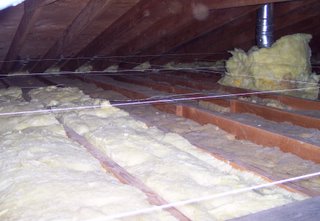I called 3 lumber yards and Menards. They all told me most people now insulate with blown-in insulation as it is faster and cheaper than using fiberglass batts.
The next thing I learned was: cellulose insulation. Never heard of it before. In fact I had a problem initially with saying "cellulite" instead of cellulose, and cellulite is a whole other matter. This web site describes cellulose and how to install it.
Now the question was: fiberglass or cellulose. (This web site compares the pros and cons of fiberglass vs. cellulose insulation.) Cellulose is a good deal cheaper than fiberglass, but recycled newspaper as insulation? I heard too many stories about old houses with walls insulated with newspaper, and it wasn't good.
I was leaning toward using blown-in fiberglass insulation but then read that the greater the temperature difference between the heated ceiling and the house's roof, the more the fiberglass's R value is lost. That's because blown-in fiberglass allows more movement of air within its air pockets and this movement allows heat to escape.
According to the "Ask the Builder" web site:
"The R-value of blown-in fiberglass insulation can be affected by temperature differences in very cold climates. In fact, it can lose up to 50 percent of its R-value when the temperature differential between the heated space and the unheated attic is significant."
North Dakota can be cold in the winter.
The University of Massachusetts has a good article on cellulose insulation with the R values for various types of insulating materials. Cellulose has a higher R value per inch (R3.5) than blown-in fiberglass (R2.5).
Mom's attic is not that large so there isn't room to pile a high layer of blown fiberglass. 12 inches is what I want to add. Menards' cellulose has a R value of 3.7. Factoring in the estimated 20% settling that cellulose does means: 12 * 80% = 9.6 * R3.7 = 35.5 + 11 = R46. Close enough to R49 to suit me. Fiberglass does not settle: 12 * R2.5 = 30 + 11 = R41 total.
 Cellulose it is.
Cellulose it is.The next step with blown insulation is to protect the soffits. This is accomplished by installing baffles against the underside of the roof running from the soffit to above the insulation to allow the outside air to move into the attic.
While it is recommended to install a baffle in every second or third stud cavity, the baffles were cheap and I installed one in every stud cavity. I never have blown in insulation so I don't know how tight it will fill openings. Some cavities could still get blocked, or partially blocked, by the insulation. Another reason to put a baffle in each cavity.
The house is a split level and therefore two roofs. One attic is accessed through the closet so I had to be a contortionist to get through the closet opening into this attic. Our warmer weather was departing and by the time I finished stapling the baffles in this attic my hands and fingers were really cold.
Then off on my Wisconsin trip with hopes of warmer weather when I returned.
Only slightly warmer weather greeted me upon my return. Still, 20s F outside the house kept the attic warm enough to work in. In such an small enclosed space I don't want it much warmer.
When I installed the baffles in the second attic I found a wet spot. Huh?! The roof was re-shingled only a few years ago. But I found a dark wet spot larger than my hand along one stud. I felt it and it was wet. I saw a very small trace of white (frost) along the stud. No pipes or openings were nearby, and this was not above the bathroom. I got a ladder and climbed up outside to check the roof. That part of the roof is still under snow and ice so I couldn't check the shingles.
I called the roofer who installed the shingles. Co-incidentally he was the person I worked for as a roofer back in the fall of 1978 - a long time ago. We spent time catching up... he has grandkids now and is thinking about retirement. My, how time has flown!
Bruce felt that the wet spot could be a frost patch that melted now that the outside temperature was in the upper 20s. But why only that one spot? And why at this location? *shrug* Only thing to do is wait till spring/summer and check the spot after a good rain to see if it gets wet again. I guess we'll wait before adding more insulation to the upper attic.
Next I needed to mark 12 inches to know how high to blow the insulation. I don't want peaks and valleys in the insulation level. How does one mark 12 inches across an open enclosed space? String.
 I attached string 12 inches high from one end of the lower attic to the other. Then on the perpendicular walls until I made a grid.
I attached string 12 inches high from one end of the lower attic to the other. Then on the perpendicular walls until I made a grid.For the upper attic I only "stringed" part of it. I left the other part open to allow easy access later to the wet spot.
While cellulose insulation is fireproof, no sense taking chances. I built a metal box to create an open space around the furnace's stovepipe. I then took an extra fiberglass batt and wrapped it around the metal box. That should keep the cellulose away from the stovepipe.
Ya know... I was told blowing insulation was easier and faster than laying down batts of insulation. I don't think so. First I had to crawl around the entire roof perimeter to install the baffles, then nail the string. Two, no, three times I crawled. And I had to reach the narrow ends. Not easy in attics with a low slope and narrow ends. With batts one pushes the end of the insulation batt to the edge of the roof and therefore doesn't have to get as close.
 I was sore after I finished. Even moving boards around to crawl or lay on instead of the studs, sometimes I still had to lay across studs to reach the roof end.
I was sore after I finished. Even moving boards around to crawl or lay on instead of the studs, sometimes I still had to lay across studs to reach the roof end.The photo to the right was taken in the lower (taller) attic. The top attic has such a small slope I could only move on my hands and knees in the very center of the roof. Otherwise I had to crawl in that attic. Slow going!
The day after I finished the "stringing", and when I planned to blow the insulation, it snowed. *sigh* I have less than a week before I return to Montana and the weather is iffy. I don't want cold and windy weather for a work day as the blower sits outside and the hose comes in through an open door. Cross my fingers and hope for better weather really soon.


1 comment:
Thanks for the informative post. I found it using Blogger and will use the information on my renovation!
Post a Comment